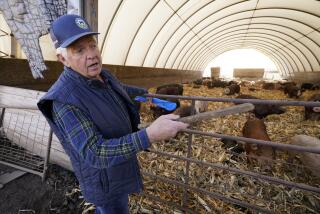Editorial: Wal-Mart’s clout buoys animal welfare

Customers walk outside of a Wal-Mart store in San Jose in 2013. Wal-Mart, the nation’s largest food retailer, is urging its thousands of U.S. suppliers to curb the use of antibiotics in farm animals and improve treatment of them.
- Share via
When the giant retailer Wal-Mart recently announced that it would ask all suppliers of fresh and frozen meat, deli, dairy and egg products to its Wal-Mart and Sam’s Club stores in the U.S. to abide by sweeping new guidelines for the humane treatment of farm animals and the reduction of antibiotic use in raising them, animal welfare groups declared that this would prompt nothing short of a sea change in animal agriculture.
Indeed, Wal-Mart has taken a significant and sophisticated position on farm animal welfare, calling for suppliers to report and take disciplinary action in cases of animal abuse and to replace cramped housing units that don’t let animals move around or socialize. The latter change would eliminate battery cages for hens, gestation crates for pregnant sows and veal calf crates. California is one of a handful of states that outlaws such housing, but Wal-Mart’s guidelines could push more suppliers across the country to adopt the new standards.
Suppliers are also being asked to stop procedures such as tail docking, de-horning and castration without pain management and to make sure animals are rendered insensible to pain before slaughter. The guidelines ask suppliers to provide animal welfare reports to Wal-Mart and to the public.
A Wal-Mart spokesman said its new position is a response to company research that found 77% of Wal-Mart shoppers would increase their trust in a retailer that practiced humane treatment of livestock, and 66% would be more likely to shop at such a retailer.
Wal-Mart is specifically calling this a position statement, not a mandate with a deadline for compliance, which raises the question of whether suppliers will follow through. The company insists that collaboration, not strong-arming, is its standard approach to effecting change among its suppliers and that this has been successful time and again. As evidence, it cites its work with suppliers of laundry detergents nearly a decade ago to decrease packaging and water waste; today, concentrated detergents dominate the aisles of Wal-Marts as well as all other stores. The company also worked with lightbulb and refrigerator suppliers to create more energy efficient refrigerated grocery cases — now an industry standard.
Of course, Wal-Mart is the largest grocery retailer in the nation, dwarfing its closest competitors. So even a request to its suppliers carries the weight of a mandate.
The business of factory farming is already changing as food services and retailers adopt more humane standards. The food services company Aramark says the 30 million eggs it will buy in the U.S. this year will come only from cage-free hens. Smithfield, the world’s large hog producer, plans to complete its conversion from gestation crates to group housing for pregnant sows by the end of 2017.
But not all animal product suppliers have made the often costly leap to humane housing. Even in states where it’s the law, businesses have resisted. Egg producers unsuccessfully lodged four lawsuits against California’s requirements that in-state farmers provide roomier housing for egg-laying hens and that out-of-state suppliers follow the same regulations if they want to sell their eggs here. And animal welfare groups contend that many egg producers in California are not effectively meeting the new standards. How many suppliers will make changes they’re not required to make?
The key issue now is whether Wal-Mart’s goals are more than merely aspirational. Will the company monitor suppliers to see whether animals have more space? The least it can do is make sure that egg farmers in California are complying with the law.
Wal-Mart executives have clearly seen that this is the direction in which the industry is moving and it’s what the public wants. But the company may need to nudge some of its suppliers to embrace that new vision.
Follow the Opinion section on Twitter @latimesopinion and Facebook
More to Read
A cure for the common opinion
Get thought-provoking perspectives with our weekly newsletter.
You may occasionally receive promotional content from the Los Angeles Times.










